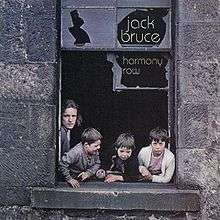Harmony Row
| Harmony Row | ||||
|---|---|---|---|---|
 | ||||
| Studio album by Jack Bruce | ||||
| Released | July 1971 | |||
| Recorded |
January 1971 (except track #13, recorded October 1969) | |||
| Genre | Rock, jazz-rock, blues-rock | |||
| Length |
42:39 (initial release), 57:01 (2003 reissue) | |||
| Label |
Atco (initial US release, SD 33-365) Polydor (initial UK release, 2310 107; 2003 reissue, 065 605-2) | |||
| Producer | Jack Bruce | |||
| Jack Bruce chronology | ||||
| ||||
| Professional ratings | |
|---|---|
| Review scores | |
| Source | Rating |
| Allmusic | |
| The Village Voice | C+[2] |
Harmony Row is the third studio album by Scottish musician Jack Bruce, originally released in July 1971.
The album takes its title from a tenement street in Glasgow, near where Bruce grew up.[3] The street, since demolished, was famous as the largest unbroken houserow in Europe, stretching for over a mile.[4] The album's cover photo was taken near the Harmony Row tenement.[5]
Although since cited by Bruce as his favourite solo album,[6] Harmony Row did not chart upon its release (it did continue to sell over a long period of time consistently). The album would be his last solo effort for over three years, as Bruce would join the power trio West, Bruce and Laing (with whom he would record three albums) in early 1972.
The song "The Consul at Sunset", which was inspired by the Malcolm Lowry novel Under the Volcano, was released as a single in 1971 (Polydor 2058-153, b/w "A Letter of Thanks").
Track listing
All lyrics composed by Peter Brown, music composed by Jack Bruce.
- "Can You Follow?" – 1:32
- "Escape to the Royal Wood (On Ice)" – 3:44
- "You Burned the Tables on Me" – 3:49
- "There's a Forest" – 1:44
- "Morning Story" – 4:55
- "Folk Song" – 4:20
- "Smiles and Grins" – 6:05
- "Post War" – 4:20
- "A Letter of Thanks" – 2:54
- "Victoria Sage" – 5:02
- "The Consul at Sunset" – 4:14
2003 CD bonus tracks
- "Green Hills" (instrumental version of "Can You Follow?") – 2:16
- "You Burned the Tables on Me" (remix including electric piano) – 4:10
- "There's a Forest" (first take) – 2:11
- "Escape to the Royal Wood (On Ice)" (instrumental demo version) – 4:01
- "Can You Follow?" (first take) – 1:32
Musicians
- Jack Bruce – vocals, bass guitar, guitar, piano, cello, keyboards
- Chris Spedding – guitar
- John Marshall – drums
Production
- Jack Bruce – producer/arranger
- Andy Johns – engineer (track #13)
- Barry Ainsworth – engineer (all other selections)
Track No. 13 recorded at Morgan Studios, London, 6 October 1969.
All other tracks recorded at Command Studios, London, mid- to late January 1971.
References
- ↑ Viglione, Joe (2011). "Harmony Row – Jack Bruce | AllMusic". allmusic.com. Retrieved 3 December 2011.
- ↑ Christgau, Robert (14 October 1971). "Consumer Guide (19)". The Village Voice. New York. Retrieved 14 April 2013.
- ↑ Liner notes to the album's 2003 reissue, Polydor Records, catalog No. 065 605-2, page 10.
- ↑ Refer to Jack Bruce's official Web site (http://www.jackbruce.com/2008/Music/Albums/harmony_row.htm). Information retrieved 5 April 2009.
- ↑ Liner notes to the album's 2003 reissue, page 10.
- ↑ Liner notes to the album's 2003 reissue, page 7.